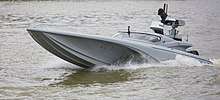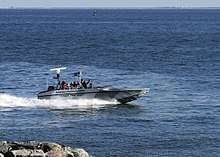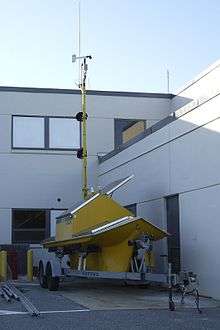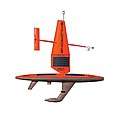Unmanned surface vehicle
Unmanned surface vehicles (USVs; also known as unmanned surface vessels (USVs) or (in some cases) autonomous surface vehicles (ASVs)) are boats that operate on the surface of the water without a crew.[1]


Development
As early as the end of World War II, remote-controlled USVs were used in minesweeping applications.[2] Since then, advances in USV control systems and navigation technologies have been achieved, resulting in USVs that can be operated remotely (by an operator on land or on a nearby vessel),[3] USVs that operate with partially autonomous control, and USVs (ASVs) that operate fully autonomously.[2] Modern applications and research areas for USVs and ASVs include commercial shipping,[4] environmental and climate monitoring, seafloor mapping,[4][5] passenger ferries,[6] robotic research,[7] surveillance, inspection of bridges and other infrastructure,[8] military, and naval operations.[2]
Oceanography

USVs are valuable in oceanography, as they are more capable than moored or drifting weather buoys, but far cheaper than the equivalent weather ships and research vessels,[9] and more flexible than commercial-ship contributions. Wave gliders, in particular, harness wave energy for primary propulsion[10] and, with solar cells to power their electronics, have months of marine persistence[11] for both academic[12][13] and naval applications.[14][15]
Powered USVs are a powerful tool for use in hydrographic survey.[7] Using a small USV in parallel to traditional survey vessels as a 'force-multiplier' can double survey coverage and reduce time on-site. This method was used for a survey carried out in the Bering Sea, off Alaska; the ASV Global 'C-Worker 5' autonomous surface vehicle (ASV) collected 2,275 nautical miles of survey, 44% of the project total. This was a first for the survey industry and resulted in a saving of 25 days at sea.[16]
Military
Military applications for USVs include powered seaborne targets and minehunting.[17]
Cargo
In the future, many unmanned cargo ships are expected to cross the waters.[18]
Saildrone
A saildrone is a type of unmanned surface vehicle (USV) used primarily in oceans for data collection.[19] Saildrones are wind and solar powered and carry a suite of science sensors and navigational instruments. They can follow a set of remotely prescribed waypoints.[20] The saildrone was invented by Richard Jenkins, a British engineer and adventurer.[21] Saildrones have been used by scientists and research organizations like the National Oceanic and Atmospheric Administration (NOAA) to survey the marine ecosystem, fisheries, and weather.[22][23] In January 2019, a small fleet of saildrones was launched to attempt the first autonomous circumnavigation of Antarctica.[24] One of the saildrones completed the mission, traveling 12,500 miles (20,100 km) over the seven month journey while collecting a detailed data set using on board environmental monitoring instrumentation.[25]
In August 2019, SD 1021 completed the fastest unmanned Atlantic crossing sailing from Bermuda to the UK,[26] and in October, it completed the return trip to become the first autonomous vehicle to cross the Atlantic in both directions.[27] The University of Washington and the Saildrone company began a joint venture in 2019 called The Saildrone Pacific Sentinel Experiment, which positioned six saildrones along the west coast of the United States to gather atmospheric and ocean data.[28][29]
 A Generation 5 Saildrone unmanned surface vehicle (USV)
A Generation 5 Saildrone unmanned surface vehicle (USV) A saildrone is recovered in Dutch Harbor, AK, after the 2019 NOAA Arctic missions
A saildrone is recovered in Dutch Harbor, AK, after the 2019 NOAA Arctic missions
See also
- Automated sailing ships
- Self-steering gear
- Spartan Scout
- Swarm robotics
References
- Yan, Ru-jian; Pang, Shuo; Sun, Han-bing; Pang, Yong-jie (2010). "Development and missions of unmanned surface vehicle". Journal of Marine Science and Application. 9 (4): 451–457. doi:10.1007/s11804-010-1033-2.
- National Research Council, Division on Engineering and Physical Sciences (5 August 2005). Autonomous Vehicles in Support of Naval Operations. National Academies Press. ISBN 978-0-309-18123-5. Retrieved 15 October 2019.
- "USV (UNMANNED SURFACE VEHICLE), APPLICATIONS AND ADVANTAGES". embention.com. Embention. 18 Sep 2015. Retrieved 15 Oct 2019.
- Amos, Jonathan (9 May 2019). "Autonomous boat makes oyster run". BBC News. Retrieved 2 Dec 2019.
- Carson, Daniel F. (2019). "An affordable and portable autonomous surface vehicle with obstacle avoidance for coastal ocean monitoring". HardwareX. 6: e00059. doi:10.1016/j.ohx.2019.e00059.
- "The ferry using Rolls-Royce technology that sails itself". BBC News. Finland. 3 Dec 2018. Retrieved 15 Oct 2019.
- Manley, Justin E. (2008). "Unmanned Surface Vehicles, 15 Years of Development" (PDF). IEEE Oceanic Engineering Society. Retrieved 14 Oct 2019.
- Feather, Andrew (1 Dec 2019). "MDOT: Unmanned sonar-equipped boat to make bridge inspections "safer and more efficient"". WWMT. Michigan, USA. Retrieved 2 Dec 2019.
- Stevens Institute of Technology student USV Archived 2010-08-11 at the Wayback Machine
- "Carbon Wave Glider". Retrieved 24 February 2016.
- "Robot Boats Survive Epic Voyage Across the Pacific — So Far". WIRED. 23 May 2012. Retrieved 24 February 2016.
- Autonomous Navigation and Obstacle Avoidance of Unmanned Vessels in Simulated Rough Sea States. 18 November 2011. Retrieved 24 February 2016 – via YouTube.
- "Robotica - An experimental setup for autonomous operation of surface vessels in rough seas - Cambridge Journals Online". Retrieved 24 February 2016.
- This story was written Amanda D. Stein; Naval Postgraduate School Public Affairs. "NPS Acquires Two USVs, Opens Sea Web Lab for Expanded Undersea Warfare Research". Retrieved 24 February 2016.
- "Information Dissemination: Eureka! Wave Glider". Retrieved 24 February 2016.
- Andrew Orthmann (2016-11-22). "Bering Sea ASV Force Multiplier". Hydro-international.com. Retrieved 2018-05-10.
- "United States Navy Fact File: MINE COUNTERMEASURES UNMANNED SURFACE VEHICLE (MCM USV)". navy.mil. United States Navy. 2 Jan 2019. Retrieved 14 Oct 2019.
- "Unmanned cargo ships". Hellenic Shipping News. 17 March 2017. Retrieved 27 May 2018.
- "Drones at sea: Unmanned vehicles to expand data collection from far-flung locales - National Oceanic and Atmospheric Administration". www.noaa.gov.
- Fisher, Adam (2014-02-18). "The Drone That Will Sail Itself Around the World". Wired. ISSN 1059-1028. Retrieved 2019-02-13.
- "Bloomberg - Are you a robot?". www.bloomberg.com. Retrieved 2019-02-13.
- "Saildrones go where humans can't — or don't want to — to study the world's oceans". The Seattle Times. 2018-07-01. Retrieved 2019-02-13.
- "Saildrone Hopes Its Robotic Sailboats Can Save the World by Collecting Precise Climate-Change Data". Inc.com. 2017-06-13. Retrieved 2019-02-13.
- "Saildrone Fleet Launches in New Zealand on Epic Journey". www.saildrone.com. Retrieved 2019-02-13.
- Vance, Ashlee (5 Aug 2019). "Saildrone's Journey Around Antarctica Uncovers New Climate Clues". Bloomberg Businessweek. Retrieved 15 Oct 2019.
- Dimitropoulos, Stav (2019-11-19). "The New Ocean Explorers". Popular Mechanics. Retrieved 2020-02-13.
- "Saildrone USV Completes First Atlantic Crossing East to West". www.saildrone.com. Retrieved 2020-02-13.
- "The Saildrone Pacific Sentinel Experiment". University of Washington. Retrieved 11 November 2019.
- "Can Autonomous Weather-Observation Sailboats Improve Forecasts over the U.S.?". Cliff Mass Weather and Climate Blog. Retrieved 11 November 2019.
| Wikimedia Commons has media related to Unmanned surface vehicles. |